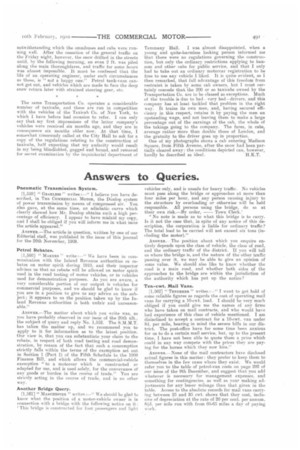Answers to Queries.
Page 17

If you've noticed an error in this article please click here to report it so we can fix it.
Pneumatic Transmission System.
11,559] " GEARLESS " writes :--" I believe you have described, in THE COMMERCIAL MOTOR, the Dunlop system of power transmission by means of compressed air. You also gave, at the same time, an adiabatic curve which clearly showed how•Mr. Dunlop obtains such a, high percentage of efficiency. I appear to have mislaid my copy, and I shall be obliged if you will inform me in what issue the article appeared."
ANSWER.—The article in question, written by one of our Editorial staff, was published in the issue of this journal for the 26th November, 1908.
Petrol Rebates.
[1,560] " MAKERS write:—'' We have been in communication with the Inland Revenue authorities re rebates on motor spirit during 1910, and their inspector advises us that no rebate will be allowed on motor spirit used in the road testing of motor vehicles, or in vehicles used for demonstration purposes. As you are aware, a very considerable portion of our output is vehicles for commercial purposes, and we should be glad to know if you are in a position to give us any advice on the subject; it appears to us the position taken up by the Inland Revenue authorities is both unfair and unreasonable."
ANSWER.—The matter about which you write was, as you have probably observed in our issue of the 20th ult., the subject of query and reply No. 1,552. The S.M.M.T. has taken the matter up, and we recommend you to apply to it for information as to the latest position. Our view is, that you can substantiate your claim to the rebate, in respect of both road testing and road demonstration, by reason of the fact that such a consumption strictly falls within the terms of the exemption set out in Section I (Part 1) of the Fifth Schedule to the 1909 Finance Bill, and which allows the commercial-vehicle exemption " to a motorcar which is constructed or adapted for use, and is used solely, for the conveyance of any goods or burden in the course of trade." You are strictly acting in the course of trade, and in no other way.
Another Bridge Query.
[1,561] a MANCHESTER " writes :—" We should be glad to know what the position of a motor-vehicle owner is in connection with a bridge with the following notice on it:
This bridge is constructed for foot passengers and light vehicles only, and is unsafe for heavy traffic. No vehicles must pass along the bridge or approaches at more than four miles per hour, and any person causing injury to the structure by overloading or otherwise will he held responsible. All persons using the bridge, do so at their own risk.—By order, — Town Clerk.'
"No note is made as to what this bridge is to carry. Is it not the case that, in spite of any notice of this description, the corporation is liable for ordinary traffic? The total load to be carried will not exceed six tons (including the motor)."
ANSWER. The position about which you enquire entirely depends upon the class of vehicle, the class of road, and the ordinary traffic of the district. If you will tell us where the bridge is, and the nature of the other traffic passing over it, we may he able to give an opinion of iome value. We should also like to know whether the road is a main road, and whether both sides of the approaches to the bridge are within the jurisdiction of the authority which has put up the notice?
Ten-cwt. Mail Vans.
[1,562] " TENDERER" writes :--" I want to get hold of some reliable figures as regards the cost of operating mail vans for carrying a 10-cwt. load. I should be very much obliged if you could give me the names of any firms who have taken on mail contracts, and who would have had experience of this class of vehicle mentioned. I am disinclined to accept a contract for a 10-cwt. van under 8d. per mile, bearing in mind the severe hills in our district. The post-office have for some time been anxious for us to do a certain mail service, but, up to the present time. I have not been able to quote them a price which could in any way compete with the prices they are paying for the horses which they now hire."
ANswes.--None of the mail contractors have disclosed actual figures in this matter : they prefer to keep them to themselves in the few cases where they exist. We would refer you to the table of petrol-van costs on page 292 of our issue of the 9th December, and suggest that you add whatever is necessary for management expenses, and something for contingencies. as well as your making adjustments for any lesser mileage than that given in the table. Access to the absolute records for mail vans carrying between 25 and 35 cwt. shows that they cost, inclusive of depreciation at the rate of 20 per cent, per annum, 80. per mile run with from 60-65 miles a day of paying work.




















